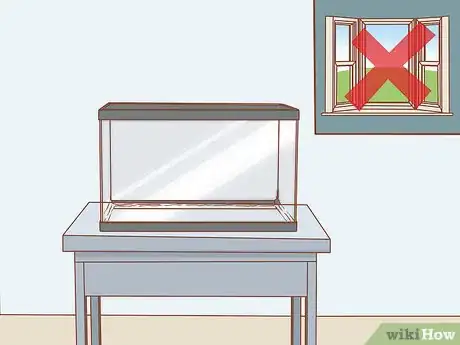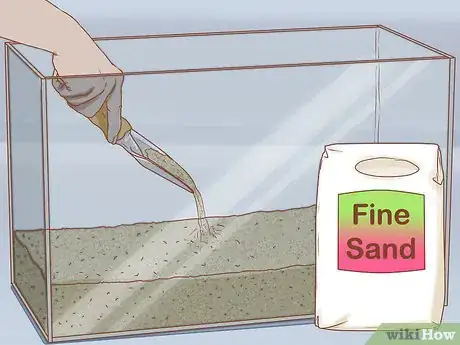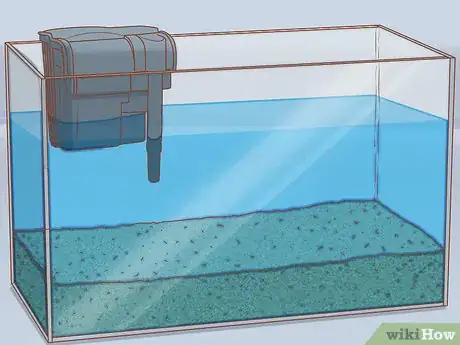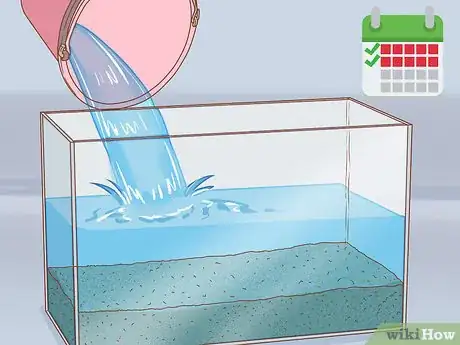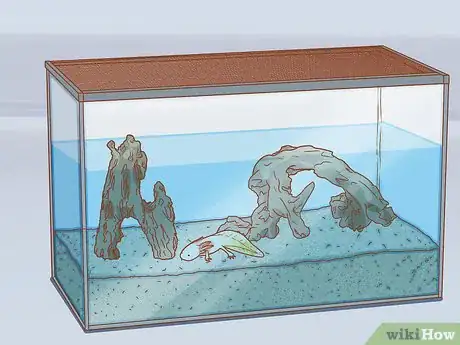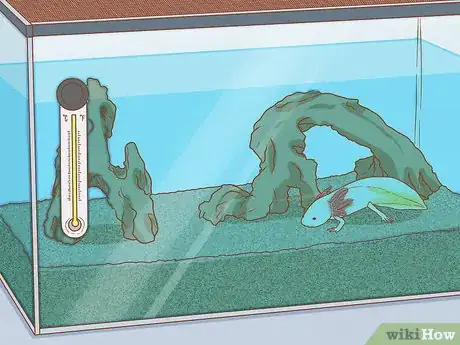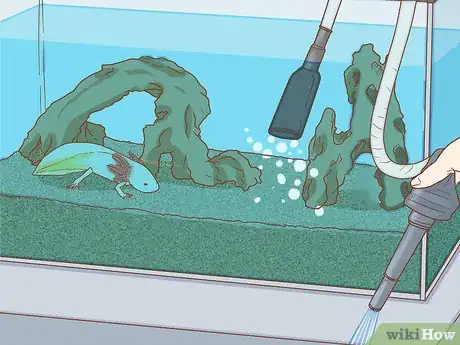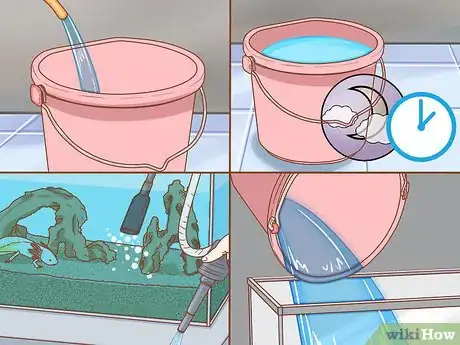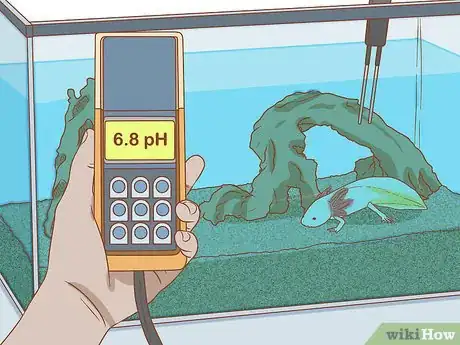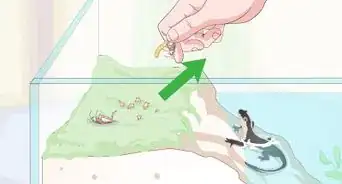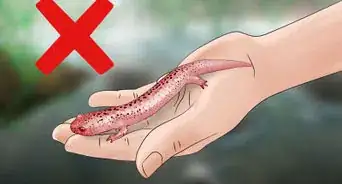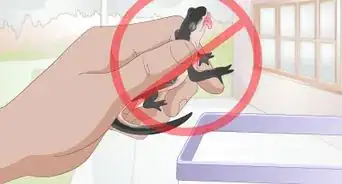This article was co-authored by wikiHow staff writer, Hunter Rising. Hunter Rising is a wikiHow Staff Writer based in Los Angeles. He has more than three years of experience writing for and working with wikiHow. Hunter holds a BFA in Entertainment Design from the University of Wisconsin - Stout and a Minor in English Writing.
There are 8 references cited in this article, which can be found at the bottom of the page.
wikiHow marks an article as reader-approved once it receives enough positive feedback. In this case, 91% of readers who voted found the article helpful, earning it our reader-approved status.
This article has been viewed 75,748 times.
Learn more...
Axolotls, or Mexican walking fish, are aquatic salamanders that keep their external gills even as adults.[1] If you want an interesting aquarium pet, keeping an axolotl is a relatively easy process as long as they’re legal to own in your area. As long as you maintain a cold aquarium with hiding spots, you can have a unique pet of your own!
Steps
Setting up the Aquarium
-
1Get a 20 US gal (76 L) aquarium tank. Find a tank that’s about 30 inches (76 cm) long, 12 inches (30 cm) wide, and 12 inches (30 cm) tall so your axolotl has room to swim around.[2]
- Don’t keep axolotls in a tank with other fish or species. Axolotls may try to eat smaller fish, and larger animals could get aggressive with your axolotls.
Tip: Get a tank 10 US gal (38 L) larger for each additional axolotl you own.
-
2Put the tank away from windows and out of direct sunlight. Axolotls are sensitive to light and should be kept away from windows and sun. Keep your aquarium in a lower level of your house where the lighting remains constant throughout the day.[3]
- Sunlight can also heat your tank and stress out your axolotls.
Advertisement -
3Line the bottom of the tank with 3 in (7.6 cm) of fine sand or large rocks. Axolotls will try to eat anything that fits in their mouth, so pebbles will get stuck in their digestive system. Look for fine aquarium sand or rocks larger than the axolotl’s head to line the bottom of your tank.[4]
- Sand or rock substrates can be purchased from your local pet or aquarium store.
- Fine aquarium sand is small enough to pass through the axolotl’s digestive system without causing any harm.
- Don’t leave the bottom of your tank bare since axolotls cannot grip glass easily and may become stressed.
-
4Attach a filter with minimal water flow to the side of the tank. Axolotls prefer slow-moving water and get stressed in high currents. Visit your local pet store to find an aquarium filter with the slowest current, such as a sponge filter. Install the filter on the side of your tank following the manufacturer’s instructions.[5]
- If you can’t a filter with a slow current, put aquatic plants in front of it to lessen the flow
-
5Fill the tank with dechlorinated water 2-3 weeks before getting an axolotl. Tap water can contain chlorine which could harm your axolotl over time. If you plan on using tap water, either add a dechlorinating agent to treat it immediately or allow the chlorine to naturally evaporate over the course of a day. Keep the water in your tank for a few weeks before housing an axolotl so it has time to cycle.
- Dechlorinating agents can be purchased from your local pet store or online.
-
6Cover the tank with a mesh lid. Axolotls can jump out of an open-top aquarium, which could be fatal to them. Make sure your aquarium comes with a mesh lid since it helps control the water temperature and protects your pets.[6]
- If your tank didn’t come with a mesh lid, check your local pet store or online for one.
Adding Fixtures to the Tank
-
1Place 1-2 hollow rocks or pipes so your axolotl has a hiding place. Axolotls are nocturnal and sensitive to bright lights, so they need places to hide during the day. Look for hollow rocks or ceramic shelters at your local pet store to put in your aquarium. Otherwise, use PVC pipes with a 2–3 in (5.1–7.6 cm) circumference for simple hiding holes.[7]
- Provide multiple hiding places if you’re housing more than 1 axolotl. Each axolotl should have its own place to hide.
-
2Keep 3-4 sturdy cold-water plants in your aquarium. Axolotls may bump into plants and uproot them if they don’t have a sturdy base. Look for freshwater plants at your local pet or aquarium store. Keep the plants you buy in small pots when you place them in your axolotl tank so they don’t get knocked over.[8]
- Plants like Java ferns can be anchored to decorations, such as large rocks or driftwood.
- If you don’t want to care for or prune aquatic plants, use artificial plants instead.
- Put your plants in front of your filter if it has a strong current.
Common Freshwater Plants
Java fern
Water Wisteria
Anubias Nana
Marimo moss[9] -
3Put in other smooth rocks or driftwood for extra decoration. Axolotls have poor eyesight, so they tend to bump into their surroundings. Avoid decorations or rocks that have sharp or jagged edges since they could damage your axolotl’s skin. Instead, use 2-3 smooth structures such as driftwood or solid rocks to beautify your tank more.[10]
- Adding decoration to your tank is optional.
Maintaining the Tank for Axolotls
-
1Keep your aquarium below 70 °F (21 °C). Axolotls natively live in cold water and get stressed out in hot water. Avoid keeping your tank in direct sunlight or on upper floors of your home. Keep the aquarium in a room away from windows and monitor the temperature daily.[11]
- Keep a thermometer in your axolotl tank so you can check the temperature at a glance.
- Axolotls can handle temperatures as low as 40 °F (4 °C).
Keeping the Tank Cold
Point a fan at the water's surface to encourage cooling and evaporation.
Add 5-6 ice cubes to your tank to bring down the overall temperature.
Keep a frozen water bottle dipped 1 in (2.5 cm) into the water in the corner of your tank.
-
2Clean any waste along the substrate with a siphon each week. Axolotl waste looks like dirt and has a high level of ammonia that affects the balance of your water. To clean it, put the end of your siphon hose in a bucket. Put the other end of your siphon into the aquarium face down. Hold the siphon against your substrate so it creates a vacuum that lifts the waste.[12]
- Water siphons can be purchased from your local pet store.
-
3Change 25% of the water in your tank every week. Fill a bucket full of tap water the night before you perform the water change so the chlorine can evaporate. Siphon 25% of the water in your tank into another bucket to remove it. Pour the bucket of water you prepared the night before slowly into the tank so it doesn’t shock your axolotls.
- If you need to perform a water change on the same day, use a dechlorinating agent in your tap water.
-
4Monitor the pH of your water once a week. Axolotls can survive anywhere between a pH level of 6.5-8.0. Use a pH water meter to check the levels of your tank to see if they’re in a healthy range. If your pH is too low, raise the pH by performing a water change or adding 1 tsp (4.8 g) of baking soda for every 5 US gal (19 L) in your tank. For a pH that’s too high, put 2-3 almond leaves on the bottom of your tank.[13]
- Make any pH adjustments slowly so you don’t shock your axolotls.
- After you make a pH adjustment, check the levels again the following day to see how it has changed.
Community Q&A
-
QuestionCan I keep a suckerfish in the tank to help with algae?
 Community AnswerNo, I wouldn't recommend it. The suckerfish might injure the axolotl, or the axolotl might prey on the suckerfish.
Community AnswerNo, I wouldn't recommend it. The suckerfish might injure the axolotl, or the axolotl might prey on the suckerfish. -
QuestionWould it be better to have the tank on the ground or on a table?
 Community Answerit would be better if it was on a table. Dirt and other things are more likely to get in the tank and hurt the fish.
Community Answerit would be better if it was on a table. Dirt and other things are more likely to get in the tank and hurt the fish. -
QuestionIs it easier to take care of a male, or female axolotl?
 Community AnswerIt's the same either way. The female and the male need the same amount of care.
Community AnswerIt's the same either way. The female and the male need the same amount of care.
Warnings
- Don’t house an axolotl with different species. The axolotl may try to eat other fish, or the fish will try to eat your axolotl’s gills.[14]⧼thumbs_response⧽
- Make sure owning an axolotl is legal in your area before you purchase one. Some places where axolotls are illegal to own are California and New Jersey.[15]⧼thumbs_response⧽
Things You’ll Need
- 20 US gal (76 L) aquarium tank
- Fine sand or large rock substrate
- Low current water filter
- Mesh tank lid
- Hollow rocks or PVC pipes
- Aquatic rocks
- Cold-water plants
- Water siphon
- Bucket
- pH meter
References
- ↑ http://advancedaquariumconcepts.com/axolotl-care-guide/
- ↑ http://www.tfhmagazine.com/details/articles/the-axolotl-a-unique-option-for-the-aquarium-full-article.htm
- ↑ http://www.tfhmagazine.com/details/articles/the-axolotl-a-unique-option-for-the-aquarium-full-article.htm
- ↑ http://advancedaquariumconcepts.com/axolotl-care-guide/
- ↑ http://www.tfhmagazine.com/details/articles/the-axolotl-a-unique-option-for-the-aquarium-full-article.htm
- ↑ http://www.axolotl.org/housing.htm
- ↑ http://www.tfhmagazine.com/details/articles/the-axolotl-a-unique-option-for-the-aquarium-full-article.htm
- ↑ http://www.tfhmagazine.com/details/articles/axolotls-keeping-a-water-monster-full.htm
- ↑ http://www.tfhmagazine.com/details/articles/the-axolotl-a-unique-option-for-the-aquarium-full-article.htm
- ↑ http://www.tfhmagazine.com/details/articles/the-axolotl-a-unique-option-for-the-aquarium-full-article.htm
- ↑ http://www.tfhmagazine.com/details/articles/axolotls-keeping-a-water-monster-full.htm
- ↑ https://youtu.be/H6E92hhiWf8?t=91
- ↑ http://www.axolotl.org/requirements.htm
- ↑ http://www.tfhmagazine.com/details/articles/the-axolotl-a-unique-option-for-the-aquarium-full-article.htm
- ↑ https://youtu.be/wmMKxNmUs-s?t=26
About This Article
To house a pet axolotl, keep the salamander in a 20-gallon aquarium so that it has plenty of room. Be sure to position the tank out of direct sunlight and make sure the water temperature stays below 70 °F to keep your pet comfortable. Line the bottom of the tank with fine sand or large rocks and attach a filter with minimal water flow to the side, since axolotls prefer slow-moving water. Don't forget to clean the tank and change out 25% of the water once per week! For tips on monitoring the tank's pH, read on!

